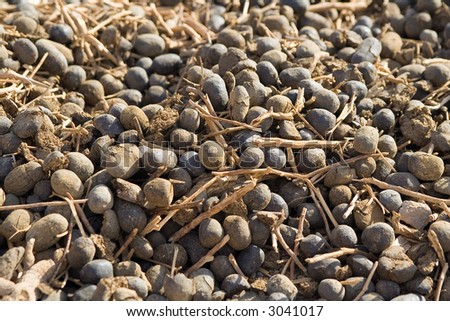
Posted on 09/15/2012 12:17:45 PM PDT by Young Werther

A strange picture of odd, spherical rock formations on Mars from NASA's Opportunity rover has scientists scratching their heads over what exactly they're looking at.
The new Mars photo by Opportunity shows a close-up of a rock outcrop called Kirkwood covered in blister-like bumps that mission scientists can't yet explain. At first blush, the formations appear similar to so-called Martian "blueberries" — iron-rich spherical formations first seen by Opportunity in 2004 — but they actually differ in several key ways, scientist said.
"This is one of the most extraordinary pictures from the whole mission," said rover mission principal investigator Steve Squyres of Cornell University in Ithaca, N.Y., in a statement. "Kirkwood is chock full of a dense accumulation of these small spherical objects. Of course, we immediately thought of the blueberries, but this is something different. We never have seen such a dense accumulation of spherules in a rock outcrop on Mars."
The new photo by Opportunity is actually a mosaic of four images taken by a microscope-like imager on its robotic arm, and then stitched together like puzzle pieces by scientists on Earth.
Rock fins up to about 1 foot (30 centimeters) tall dominate this scene from the panoramic camera (Pancam) on NASA's Mars Exploration Rover Opportunity. This image was taken Aug. 23, 2012. CREDIT: NASA/JPL-Caltech/Cornell Univ./Arizona State Univ. Opportunity on Mars
The Mars rover Opportunity is currently exploring a location known as Cape York along the western rim of a giant Martian crater called Endeavour. Opportunity is one of two golf cart-size NASA rovers that landed on Mars in January 2004 (Spirit was the other) to explore different landing sites.
The solar-powered rovers were initially expected to last just 90 days on Mars, but each survived for years on the Red Planet. Spirit stopped communicating with Earth in 2010, but Opportunity is still operational.
Despite its advanced age, Opportunity is still pumping out new discoveries after more than eight years on Mars. The rover first spotted Martian blueberries soon after its landing in 2004. The blueberries are actually concretions created by minerals in water that settled into sedimentary rock.
Opportunity has seen Martian blueberries at many of its science sites during its Red Planet exploits, but the bumpy, spherical formations on the Kirkwood rock represent something new, researchers said. In Opportunity's new photo, many of the strange features are broken, revealing odd concentric circles inside.
"They seem to be crunchy on the outside, and softer in the middle," Squyres said. "They are different in concentration. They are different in structure. They are different in composition. They are different in distribution. So, we have a wonderful geological puzzle in front of us." [7 Biggest Mars Mysteries]
Squyres said he and his science team have several theories, but none that truly stand out as the best explanation for what could have created the weird bumps on Mars.
"It's going to take a while to work this out, so the thing to do now is keep an open mind and let the rocks do the talking," he said.
Mars Myths & Misconceptions: QuizNo planet is more steeped in myth and misconception than Mars. This quiz will reveal how much you really know about some of the goofiest claims about the red planet. 0 of 10 questions completeMars Myths & Misconceptions: QuizNo planet is more steeped in myth and misconception than Mars. This quiz will reveal how much you really know about some of the goofiest claims about the red planet. 0 of 10 questions complete Start Over | More Quizzes A Martian spring
The Kirkwood outcrop is just one science pit stop at Cape York for Opportunity. Mission scientists have already picked out another interesting rock outcrop nearby, a pale patch that may contain tantalizing clay minerals, for possibly study after Opportunity completes its current analysis.
Meanwhile, the spring equinox is approaching on Mars, ensuring increasing levels of sunshine for Opportunity's solar arrays.
"The rover is in very good health considering its 8-1/2 years of hard work on the surface of Mars," said rover project manager John Callas of NASA's Jet Propulsion Laboratory in Pasadena, Calif., in a statement. "Energy production levels are comparable to what they were a full Martian year ago, and we are looking forward to productive spring and summer seasons of exploration."
Fossilized bubbles.
It looks like it was the last planet where followers of Islam became militant movie critics.
The Mars rovers were designed for a life of 90 days and a couple of hundred meters.
This is one of the few government contracts that exceeded specs. Opportunity is the B-52 of Mars.
/johnny
Where would YOU want to go??
It will be fun when they find gold.

“They seem to be crunchy on the outside, and softer in the middle,” Squyres said.
Chocolaty center, crunchy candy shell?
The mother lode of M&Ms!
Alien eggs. Bring some back.
The Marsian national reserve of dingleberries.

Camel dung

Frozen mud bubbles. ... sheesh!
Alien eggs. Bring some back.
Of course, what could go wrong.
It’s not like they could hatch or anything.

So this is where the boy's "lost marbles" went from Peter Pan.
Ancient Alien golf range, after the nuclear powered ball picker broke down!
Paleo daleks.
I wouldn't be surprised to find glassivation at the edge of a crater, which this photo sort of resembles.
Disclaimer: Opinions posted on Free Republic are those of the individual posters and do not necessarily represent the opinion of Free Republic or its management. All materials posted herein are protected by copyright law and the exemption for fair use of copyrighted works.